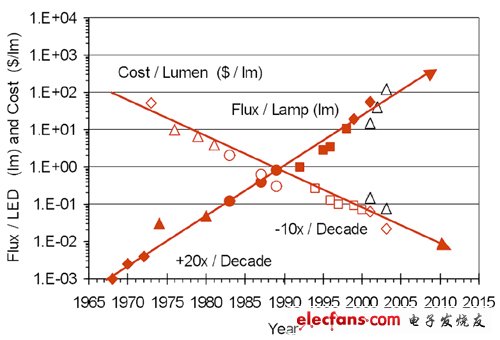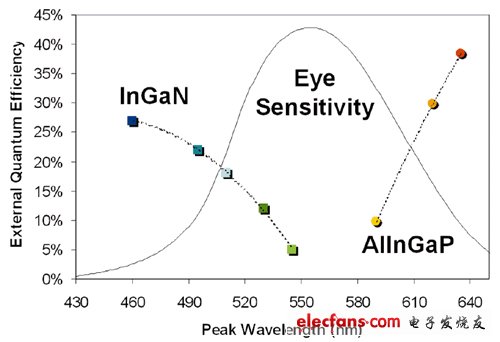Analysis of the principle technology of "package thermal conductivity"
Foreword: In the past, when LEDs could only be used as status indicators, its package heat dissipation has never been a problem, but in recent years, the brightness and power of LEDs have been actively improved, and they have been used for backlighting and electronic lighting applications. The package heat dissipation problem has emerged quietly.
The above lecture sounds a bit confusing. Hasn't it always emphasized the brightness breakthrough of LED today? In 2003, Mr. Roland Haitz of Lumileds LighTIng Company based on an empirical technology deduction law based on past observations, starting from the first commercial LED in 1965. During the development of more than 30 years, the LED is about every 18 months The brightness can be doubled in 24 months, and in the next 10 years, it is expected that the brightness can be increased by another 20 times, and the cost will be reduced to 1/10 of the existing. This is also the Haitz law that has become popular in recent years, and is Think of it as Moore's law in the LED world.
According to the deduction of Haitz's law, LEDs with a brightness of 100lm / W (100 lumens per watt) appeared around 2008 and 2010, but the actual development seems to have been ahead of the law, June 2006, Nichia Engineering samples of white LEDs up to 100lm / W have already been provided, and mass production is expected to be officially launched by the end of the year.

Remarks: Haitz's law can be said to be Moore's law in the field of LED. According to Roland Haitz, LED has doubled its luminous efficiency almost every 1824 months in the past 30 years, and therefore estimated the next 10 years (2003) (2013) will increase the brightness by 20 times, but the price will be only 1/10 of the current.
Not only the brightness has been continuously improved, but the heat dissipation technology of the LED has also been improved. In 1992, the thermal resistance of an LED was 360 ° C / W, and then it dropped to 125 ° C / W, 75 ° C / W, and 15 ° C / W. Now it has reached the point of 6 ℃ / W and 10 ℃ / W. More simply, in the past, for every 1 watt of LED power consumption, the temperature will increase by 360 ℃, now it is the same consumption of 1 watt of power, but the temperature only rises by 6 ℃ 10 ℃.
A small number of high brightness, multiple and densely arranged are the culprits of heat increase
Since brightness efficiency and heat dissipation efficiency have improved, isn't that even more contradictory? There should be no more heat dissipation problems? In fact, it should be more strictly stated that the exacerbation of heat dissipation problems is not at high brightness, but at high power; not in traditional packaging, but in new packaging and new applications.
First of all, the LED used to be the indicator light in the past, each single (lighting forward) current is between 5mA and 30mA, typically 20mA, and the current high-power LED (Note 1) is Each single piece of current will have 330mA1A of current fed in. "Each piece of electricity" has increased ten times, or even tens of times (Note 2).
Note 1: In addition to increasing the area of ​​a single light-emitting die, the existing high-power LED method also adopts the method of packaging multiple die together. In fact, some white LEDs are mixed with bare crystals of three primary colors of red, green and blue in the same package to mix out white light.
Note 2: Although the lighting (forward conduction) voltages of various LEDs are different, this difference is ignored for now.
When the multiplied current is fed into the same single package, the heat will naturally double, so the heat dissipation will of course deteriorate, but unfortunately, because the white LED is used as the flash of the camera phone, it is used for small lighting To use a light bulb as a lighting bulb in a projector, high brightness is not enough, but high power is also required. At this time, heat dissipation becomes a problem.
The above-mentioned LED application method only uses a few high-power LEDs, about 14 flashes, about 18 lighting bulbs, and more than 10 in the projector. However, there are few opportunities to use the flash, and the lighting time is not long. The lamp has a relatively large room for heat dissipation, and although there is no room for heat dissipation in the projector, a cooling fan can be installed.

Remarks: The figure shows the InGaN and AlInGaP semiconductor materials for two LEDs. The external quantization efficiency graph at each peak wavelength (light color) can be approximated to 40% under ideal conditions. However, if the light extraction efficiency is included Consider, in fact, between 15% and 25%, not to mention that the higher efficiency of the two materials is not within the scope of human eye sensitivity, only 20% under the category.
However, there are still many applications that require high brightness, but high-brightness LEDs are required to be densely arranged and used, such as traffic signal lights, message signboards, and video walls made up of LED groups. The result of dense arrangement is It is not easy to dissipate heat. This is a heat dissipation problem caused by the application.
What's more, on the backlight of the LCD TV, both high-brightness LEDs are used, and they must be densely arranged. In order to pay attention to the short and thin, the heat dissipation design space available on the back is more restricted, and it should not be seen if the high standard requirements Use a cooling fan, because the noise of the fan will affect the taste of TV watching.
Rotary Switch Food Blenders by turning the knob to control blenders. Usually Rotary Switch Food Blenders have 2 or 4 speeds with pulse. And safety lock is optional.
Discription of Rotary Switch Food Blenders
Size: 1.0L,1.25L, 1.5L, 1.6L
Housing: ABS, PP, Stainless steel
Speed: 2 or 4 speeds with pulse

Rotary Switch Food Blenders
Rotary Switch Food Blenders,Juicer Blender,Baby Food Blender,High Speed Stand Blender
Flying Electronic Co., Ltd , https://www.flyingelectronic.com